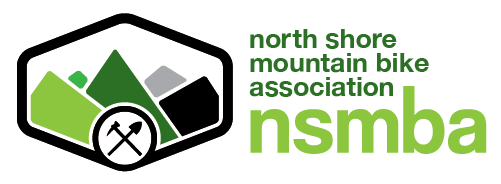What is a land acknowledgement?
The recognition of territory is a way to show respect for Indigenous peoples by testifying to their presence, both historical and current. It is important to acknowledge the Indigenous peoples who have called this land home for time immemorial as we work towards reconciliation. In an outdoor setting, land acknowledgements can be even more informative and can help make an event a more inclusive, welcoming space for participants whether they identify as Indigenous or not.
Land acknowledgements should be intentional, meaningful and accurate. It is important for whomever is delivering the land acknowledgement not to think of it as a “box to tick”. Often, it can be helpful and more meaningful for the person to situate themselves within the acknowledgement. How do you relate to the land? Are you a settler here? Why are land acknowledgements and reconciliation meaningful for you?
Our work at the NSMBA is fundamentally set in the land we build trails through. Therefore it is especially important for us to be aware of the history and stewardship of the land we are working on. By understanding this, we better respect and steward the trails we work and play on.
Learn more about land acknowledgements.
Why is a land acknowledgement important?
For non-Indigenous Canadians, land acknowledgements are an opportunity to reflect on the impacts of colonialism, and to be accountable to the Indigenous people of this land. These few words spoken at gatherings can provoke thought and reflection about colonialism and how to engage in reconciliation more meaningfully.
Who are we acknowledging?
The broader area of coastal BC is the shared territory of the Coast Salish people, but when doing land acknowledgements, it is always best to be as specific as possible and name the individual communities or nations.
The City of Vancouver is situated on the unceded shared territories of the xʷməθkʷəy̓əm (Musqueam), Sḵwx̱wú7mesh (Squamish), and səlilwətaɬ (Tsleil-Waututh) Nations.
The Musqueam, Squamish and Tsleil-Waututh Nations have a lot of overlap in terms of traditional territory. In a very general sense, the Squamish Nation extends more north and west of Vancouver, the Musqueam Nation extends more to the south and the Tsleil-Waututh Nation extends more to the north and east.
When to do a land acknowledgement?
Before any event that happens on the North Shore we want to acknowledge the land and the people who steward these lands. You may choose to do this at the beginning of an event, during your briefing for the day or once you’re in the forest on the trails.
How to do a land acknowledgement?
We encourage you to personalise your own land acknowledgement but here are some examples:
“Before we begin, I would like to acknowledge that we are gathered here today on the shared territories of the xʷməθkʷəy̓əm (Musqueam), Sḵwx̱wú7mesh (Squamish), and Səl̓ílwətaʔ/Selilwitulh (Tsleil-Waututh) people (or Nation). We respect the connection these nations have to the land and are grateful for our ability to dig/ride safely today.”
“I would like to acknowledge that where we are today is on the shared, ancestral and unceded territory of the xʷməθkwəy̓əm (Musqueam) Nation, Skwxwú7mesh (Squamish) Nation, and Səl̓ílwətaʔ/Selilwitulh (Tsleil-Waututh) Nation.”
“Today, we are trail building on land that has been stewarded by the Coast Salish peoples since time immemorial. The xʷməθkʷəy̓əm (Musqueam), Sḵwx̱wú7mesh (Squamish), and Səl̓ílwətaʔ/Selilwitulh (Tsleil-Waututh) people (or Nation) care for and live off the land and waters we are surrounded by. With appreciation and gratitude we work and live on the land today.”
“Our trails are located on the unceded and shared territories of the xʷməθkʷəy̓əm (Musqueam), Sḵwx̱wú7mesh (Squamish), and Səl̓ílwətaʔ/Selilwitulh (Tsleil-Waututh) people (or Nation). We are grateful for the opportunity to build trails, share conversations and ride bikes on these territories.”
